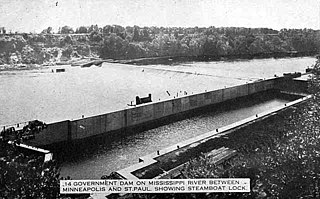
The Meeker Island Lock and Dam was the first lock and dam facility built on the Upper Mississippi River. Meeker Island was named after its owner Judge Bradley B. Meeker. Meeker County was named after him also. After a construction period lasting eight years, the site was only in operation for five years from 1907 to 1912 when the growing interest in hydroelectric power led to design and construction of today's Lock and Dam No. 1 a few miles downriver. It was realized that the new dam could take over the function provided by this first site and another small dam a short distance downriver.
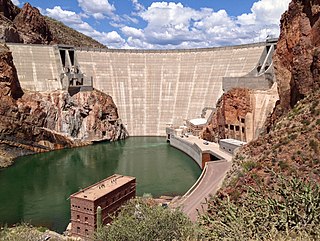
Theodore Roosevelt Dam is a dam on the Salt River located northeast of Phoenix, Arizona. The dam is 357 feet (109 m) high and forms Theodore Roosevelt Lake as it impounds the Salt River. Built between 1905 and 1911, the dam was renovated and expanded in 1989–1996. The dam is named after President Theodore Roosevelt. Serving mainly for irrigation, water supply, and flood control, the dam also has a hydroelectric generating capacity of 36 megawatts.

Folsom Powerhouse State Historic Park is a historical site preserving an 1895 alternating current (AC) hydroelectric power station—one of the first in the United States.

Lake Hamilton and Lake Catherine are a pair of man-made lakes located in Hot Springs, Arkansas, serving as a tourist attraction for the area. Both lakes were developed by Arkansas Power & Light. The lakes were built as part of Federal Project #271 a hydroelectric development for creating hydroelectric dams.

Wilson Dam is a dam on the Tennessee River between Lauderdale and Colbert counties in Alabama. Completed in 1924 by the United States Army Corps of Engineers, it impounds Wilson Lake, and is one of nine Tennessee Valley Authority (TVA) dams on the Tennessee River. It was declared a National Historic Landmark on November 13, 1966, for its role as the first dam to come under the TVA's administration. The dam is named for Woodrow Wilson.
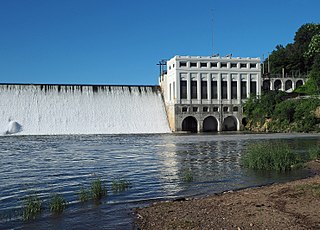
The Lake Zumbro Hydroelectric Generating Plant, also known as the City of Rochester Municipal Hydro-Electric Plant, is a hydroelectric facility on the Zumbro River in Mazeppa and Zumbro Townships in the U. S. State of Minnesota. The facility consists of a gravity dam and a powerhouse, and formerly included three houses for the plant operators. The houses were removed in the 1960s when the dam was retrofitted to allow remote operation of the generating equipment from Rochester. The impoundment created is called Lake Zumbro. This dam spans 904 feet (276 m) and is 66 feet (20 m) high, creating a reservoir with about 55 feet (17 m) of hydraulic head.

Croton Dam is an earth-filled embankment dam and powerplant complex on the Muskegon River in Croton Township, Newaygo County, Michigan. It was built in 1907 under the direction of William D. Fargo by the Grand Rapids - Muskegon Power Company, a predecessor of Consumers Energy. The 40-foot-high (12 m) dam impounds 7.2 billion U.S. gallons (6 billion imp. gal/27 billion L) of water in its 1,209-acre (489 ha) reservoir and is capable of producing 8,850 kilowatts at peak outflow. It was listed on the National Register of Historic Places in 1979.

The Pea River is a 154-mile-long (248 km) tributary of the Choctawhatchee River near Geneva, Alabama, United States. It is a popular destination for those with canoes and other small boats, as well as fishermen seeking bass, sunfish, or mullet.

River Mill Hydroelectric Project, also known as River Mill Dam and Station M, is a hydroelectric dam and powerhouse in Clackamas County, Oregon, United States. It is just north of Estacada, Oregon, on the Clackamas River at river mile 23.5. It received its name from being near a sawmill that was located along the river.

The former Saratoga Gas, Electric Light and Power Company Complex is located near the northern boundary of Saratoga Springs, New York, United States. It is a seven-acre parcel with two brick buildings on it. In the 1880s it became the thriving resort city's first power station.

The Occum Hydroelectric Plant and Dam is a historic hydroelectric plant and dam north of Bridge Street on the west side of the Shetucket River in Norwich, Connecticut. The facility includes a rare surviving partial example of a large-scale dam built for a textile mill in 1865, and an early example of a hydroelectric power generation facility established in 1934. It is one of a small number of surviving hydroelectric plants in the state which was built before 1940. The complex was listed on the National Register of Historic Places in 1996.

Long Lake Dam is a concrete gravity dam on the Spokane River, between Lincoln County and Stevens County about 30 miles (48 km) northwest of Spokane in eastern Washington. It forms Long Lake (Washington), a 23.5 mi (37.8 km) long reservoir, and has a hydroelectric generating capacity of 71 megawatts. The dam was built by Washington Water Power, which operates five other dams along the Spokane.

Salt River Hydroelectric Powerplant, on the Salt River and on the border of Idaho and Wyoming, near Etna, Wyoming, was built in 1938.
The Bodwell Water Power Company Plant, also known as the Milford Plant of Emera Maine, is a hydroelectric power generation facility on the Penobscot River in Milford, Maine. Its main building, a handsome Romanesque structure, stands at the eastern end of the Milford Dam. Built in 1906, it was at that time the largest hydroelectric facility in the state, and its construction marked a shift from water to electrical power of area industries. It was listed on the National Register of Historic Places in 1988.

Star Milling and Electric Company Historic District, also known as Star Mill Falls and Star Gristmill, is a historic industrial complex and national historic district located in Lima Township, LaGrange County, Indiana. The district encompasses one contributing building, one contributing site, and two contributing structures. They are a small hydroelectric powerhouse (1929), two dams (1929), and the site of the original 1870 grist mill / hydroelectric generating plant. The old mill generated electric power from 1911 to 1929, and in 1930 the new powerhouse began operation.

Waverly Municipal Hydroelectric Powerhouse is a historic building located in Waverly, Iowa, United States. Mills were established on both sides of the Cedar River from the earliest years of Waverly, and they created the dam across the river. The towns first electric plant was privately owned and was established in the 1880s. The city bought the water rights and the dam in 1890, a new privately operated power plant went into operation in 1896. In 1908 the power plant was destroyed in an explosion and fire. Waterloo, Iowa architect John G. Ralston in collaboration with the Fargo Engineering Company of Jackson, Michigan designed the new facility that was completed the following year. A large wing that housed three diesel electric generating units, and an office addition were completed in 1938. The red brick facility features Neoclassical details, and is located on the east bank of the Cedar River. The building was listed on the National Register of Historic Places in 2013. It was included as a contributing property in the Waverly East Bremer Avenue Commercial Historic District in 2014.
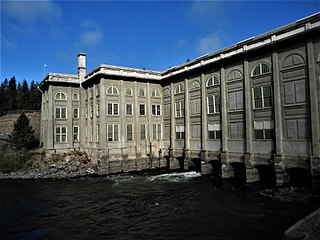
The Little Falls Hydroelectric Power Plant, on the Spokane River near Reardan, Washington, about 30 miles (48 km) west of Spokane was built during 1907–10. It was listed on the National Register of Historic Places in 1988. The listing included one contributing building and seven contributing structures on 12 acres (4.9 ha). The area spans the border of Lincoln County, Washington and Stevens County, Washington.
St. Anthony Falls in Minneapolis, Minnesota, is the only natural falls on the Mississippi River. Since almost the beginning of settlement in the area by European descendants, the St. Anthony Falls have been used for waterpower. The first allowed settlers were at Ft. Snelling, where construction began in 1820. A sawmill was operating 1821 and a flour mill in 1823. As soon as the land at the sides of the falls became available it was purchased with the intent of using the waterpower of the falls. First lumber mills covered the falls, cutting lumber floated down the Mississippi. After 1870 flour mills started to dominate the area. From 1880 to 1930 the area was the number one flour producer in the US. In later years, some of the power came from steam, but in 1923 half of the waterpower used was for flour milling. Other industries have also used the waterpower.

Fountain Green Hydroelectric Plant Historic District, located northwest of Fountain Green, Utah, was listed on the National Register of Historic Places in 1989. The listing included three contributing buildings and a contributing structure.
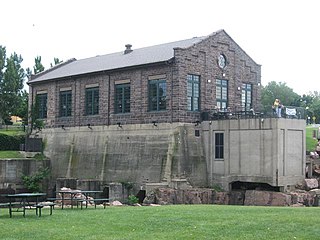
The Sioux Falls Light and Power Hydro Electric Plant, formerly the Northern States Power Building, is a historic building in Falls Park in Sioux Falls, South Dakota. Originally built as a hydroelectric power plant on the Big Sioux River, it now houses the Falls Overlook Cafe. It was listed on the National Register of Historic Places in 1993.



















